Today I picked up a mint condition Akai GX-77
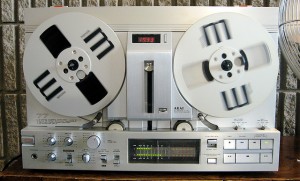
This photo is from the internet; I will upload a real photo later.
The unit does not work; the two pinch rollers won’t come down all the way and the tape loader roller in the middle is stuck at the top so I will have to fix that. The middle roller is necessary for tape loading and unloading.
auto reverse
This unit is a real beauty. It is an auto-reverse deck, and is capable of playback AND recording in both directions. Therefore it has 6 heads and two capstans. The capstans are always spinning, in opposite directions and only the pinch roller associated with the current playing direction is engaged. The result of this is that switching tape direction takes only 0,4 seconds.
other features and specs
- It has user adjustable bias through a dial on the front
- capable of using EE tape (chrome)
- L+R recording level knobs have a 3rd ‘master’ knob which controls both channels
- output level is adjustable from the front
- digital tape counter with optional backup adapter
Here are the full specs:
- Track system: auto reverse, 4-track, 2-channel, stereo system
- Heads: 2 x GX record, 2 x GX playback, 2 x erase
- Motor:
- 1x FG servo direct-current capstan motor
- 2x direct-current reel motor
- Reel size: up to 7 inch reel
- Tape speeds: 3 3⁄4 7 1⁄2 ips
- Wow and flutter: 0.03% (7 1⁄2 ips)
- Fast forward rewinding time: About 80 seconds
- Frequency response:
- 25Hz to 33kHz ±3dB (19 cm/s)
- 25Hz to 25kHz ±3dB (9.5 cm/s)
- Signal to Noise Ratio: 63dB
- Total harmonic distortion: 0.5%
- Input: 70mV (line), 2mV (DIN)
- Output: 0.775V (line), 0.3V (DIN)
- Dimensions: 440 x 244 x 227mm
- Weight: 17kg
- Power consumption: 28W
work begins
The first thing I did after opening up the unit was checking the belts. It has three: one capstan belt and two for the spooling motors. The capstan belt was ok, it was still feeling like it should, but it was probably a little stretched because it didn’t feel very tight to me. I ordered a new set which included the 2 spool motor belts for €12,-
Once I had the belts replaced, it still would not engage the middle roller. It is supposed to go up and down.
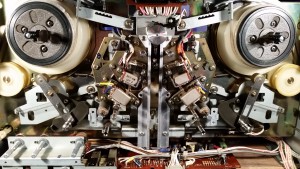
akai gx-77 with the roller stuck in top position
Searching on the internet I found that there is a large white gear wheel located behind the 2 flywheels which controls the up/down movement of the roller. When I manually engaged this wheel, everything worked. Tape was loading fine. But I had to help it every time. So what could cause this?
old dried out grease
The answer is: old grease. Old grease is grease that, over the course of 35+ years, has started to dry out and instead of lubricating, it starts clogging things. So I had to take the unit further apart to the point where every gear wheel is removed and cleaned.
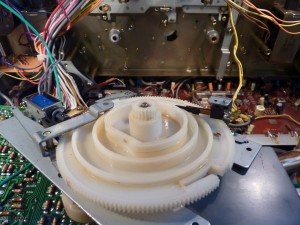
gear
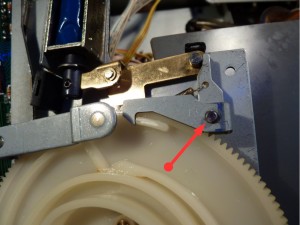
akai gx-77 plunger arm dried out grease
This plunger arm was very slow returning to it’s default position and probably missed the next turn when the hook had to engage. So I fixed that.
Also the right flywheel (as seen from the back) has a gear on it. This was also very loose on the spindle and could be turned quite easy. I put it in a ultrasonic bath and tried to clean it with IPA. Now it moves a lot rougher.
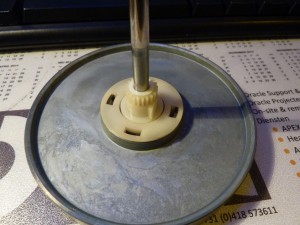
flywheel with gear
So after almost completely removing all moving parts and cleaning and re-lubing them I carefully put the unit back together to try a cautious test. Here is the result:
As you can see the unit works smoothly now. At the moment the deck is still mostly disassembled but I will put it back together again and then start the mechanical adjustments and followed by the electrical calibration.
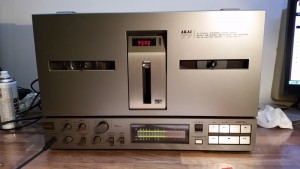
As you can see the beauty is put together again and is recording and playing like new. Very happy with it!

How fortunate I am to have found this page! It begins with a description of the very problem I’m having with my new-to-me AKAI GX-77: pinch rollers and tape roller in their up positions.
How did you removed the two screws behind the pinch rollers while they were in the up position?
Am I right in thinking that I’ll have to go in through the front to deal with the old grease that seems to have my machine essentially frozen?
I’ve managed to gain the slightest movement in some mechanisms, and this has apparently payed off with the machine at least turning (though only at one speed and with no response to any controls other the the on/off switch.
I have a couple of threads going currently on Audio Karma:
http://audiokarma.org/forums/index.php?threads/akai-gx-77-r2r-new-to-me-replace-fuse-and-go.755533/#post-10269370
http://audiokarma.org/forums/index.php?threads/manual-release-of-pinch-rollers-on-akai-r2r-looking-to-repair.755806/
Any insight you might provide that gets me further into the “guts” of this beautiful machine would be very much appreciative!
Ian
SF Bay Area
Hello Ian,
It is a wonderful machine, when it is working. But the mechanics are very sensitive.
For me it is some time ago since I took it apart, so my memory is very faint…..
I had the same problem. I believe the trick was to remove the lower part of the front, where the VU meters are, if memory serves me right.
In the end the whole machine has to be bare, completely stripped, to service it thoroughly.
Since then I have traded the unit for a Philips N4520, so it is no longer in my possession. The new owner is an AKAI lover, so that worked out fine, and I now have a troublesome N4520 that has given me a lot of headaches… 🙂
Regards,
-Philip.
I very much appreciate your taking the time to reply. Your comments and video have, at least, given me hope I can do this. Thanks!
Ian
SF Bay Area